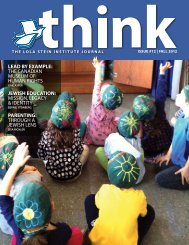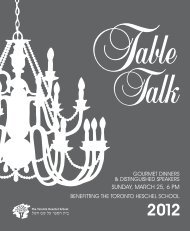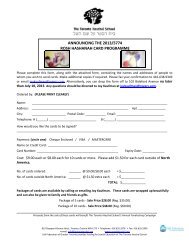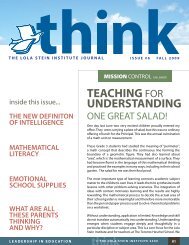Issue No. 13 - The Toronto Heschel School
Issue No. 13 - The Toronto Heschel School
Issue No. 13 - The Toronto Heschel School
You also want an ePaper? Increase the reach of your titles
YUMPU automatically turns print PDFs into web optimized ePapers that Google loves.
FEATURED ARTICLE<br />
FISHING FOR WORDS<br />
How poetry and metaphor make us literate<br />
<strong>The</strong> Jewish month of Cheshvan is called Mar Cheshvan, which<br />
means “bitter Cheshvan,” for it is the only month of the Jewish<br />
calendar in which no religious or historical festivals take place. To<br />
take the edge off bitter Chesvhan, which coincides with an often<br />
dreary Canadian <strong>No</strong>vember, <strong>The</strong> <strong>Toronto</strong> <strong>Heschel</strong> <strong>School</strong> creates<br />
its own annual celebration – a Poetry Festival. <strong>The</strong> Festival has<br />
become both an academic and soulful treasure that delights the<br />
entire school community.<br />
Coming six weeks into the school year, the Poetry Festival marks<br />
the culmination of the first unit of English Language Arts study for<br />
all students from Grades 1 to 8. With heightened concern these<br />
days over early literacy, a back-to-basics approach to reading<br />
and writing, and making sure that everyone can spell, one might<br />
wonder why our school chooses to dedicate the first full unit of<br />
the year to the study of poetry.<br />
Good writing is deeply rooted in how children think,<br />
feel, and experience the world.<br />
Many language arts programs consider poetry to be a bit of a frill<br />
– something to touch on later in the school year, once students<br />
have nailed down their particular grade level’s basic requirements<br />
for writing. Our poetry curriculum is based on the premise that<br />
good writing of any sort is, in fact, deeply rooted in how children<br />
think, feel, and experience the world. We concur with educational<br />
philosopher and psychologist Professor Kieran Egan who teaches<br />
that poetry lies at the root of human thinking and therefore<br />
deserves a formative place in the curriculum.<br />
Egan rejects the Piagetian notion that young children think<br />
concretely and are capable of the more sophisticated forms<br />
of thinking usually associated with poetry only later in their<br />
maturation. Egan asserts, “<strong>The</strong> central fact of our minds is their<br />
poetic nature.”<br />
Egan cites researchers such as Howard Gardener and Ellen Winner<br />
of the Harvard Graduate <strong>School</strong> of Education to explain further:<br />
By Greg Beiles with contributions from Lesley Cohen<br />
Human children are equipped with some specific intellectual<br />
capacities that reach their peak in our early years… For example<br />
our ability to generate appropriate metaphors reaches its peak<br />
by age five, and declines thereafter. 1<br />
According to Egan, the linguistic practices that are inherent in<br />
poetry are not advanced cognitive developments, but are, in fact,<br />
“the true basics of education.” Many elements of poetry, such as<br />
forming images from words, understanding abstract notions and<br />
appreciating the moods and emotions that different cadences<br />
and rhythms can convey, are fundamental to the way the human<br />
mind works and makes sense of the world.<br />
Egan’s point becomes clear when we recognize that the technique<br />
of metaphor, which is usually only valued as a language skill, is<br />
at play whenever children are able to understand one thing in<br />
terms of another. When a child imagines that a leaf is a bird flitting<br />
down to the ground, or an airplane soaring up in the sky, they are<br />
engaging in sophisticated metaphorical thinking. It is this same<br />
cognitive leap through metaphor that allows a child to accept<br />
the figure “4” as equivalent to four three-dimensional objects on<br />
a table.<br />
Ted Hughes is another thinker who recognizes that the techniques<br />
of expression involved in poetry closely mirrors the way the minds<br />
of children actually work. His book Poetry in the Making is one of<br />
the finest on teaching poetry. Hughes writes that reading and<br />
writing poetry amounts to “learning to think.”<br />
<strong>The</strong> thinking that we learn in poetry is a kind of thinking that we<br />
often ignore: it is the contemplative activity that helps us express<br />
our most elusive perceptions and thoughts. Hughes describes<br />
how, as a school boy, he felt “plagued” by his inability to express<br />
his thoughts in words:<br />
I became very interested in those thoughts of mine I could<br />
never catch. Sometimes they were hardly what you could call a<br />
Award-winning poet Adam Sol participating in the Poetry Festival, <strong>No</strong>vember 2012<br />
thought – they were a dim sort of feeling about something. <strong>The</strong>y<br />
did not fit into any particular subject – history or arithmetic or<br />
anything of that sort. 2<br />
Hughes writes that inchoate thoughts and feelings that belong<br />
to the world of “memory, emotion, imagination, intelligence and<br />
natural common sense” are not mere embellishments to life, but<br />
in fact constitute “the world of final reality…which goes on all<br />
the time, consciously or unconsciously, like the heart beat.” 3 <strong>The</strong><br />
“thinking” that poetry teaches is the process by which we reach<br />
this inner life.<br />
Hughes likens poetic thinking to fishing. If we do not learn this<br />
way of thinking, “then our minds lie in us like fish in the pond of a<br />
man who cannot fish.” 4 Hughes draws further on the metaphor of<br />
fishing to evoke the practices of patience, close observation and<br />
“concentration on a small point” that we use when we read and<br />
write poetry.<br />
And yet poetry is not only about reaching inside ourselves, it is also<br />
a way to communicate and share our thoughts and emotions with<br />
others. Just as science constitutes a method for investigating and<br />
sharing knowledge about natural phenomena, so poetry provides<br />
a method for exploring and sharing inner personal experiences.<br />
“...then our minds lie in us like fish in the pond of a<br />
man who cannot fish.” -Ted Hughes<br />
Metaphor – the ability to see one thing in terms of another – allows<br />
us to express unique experiences, and yet understand one another.<br />
For Robbie Burns, love is a “red, red, rose,” Leonard Cohen calls it<br />
“a broken Halleluya” and, for e.e. cummings, “nothing, not even<br />
the rain has such small hands.” Each poet describes love using a<br />
different metaphor; and yet through our common understandings<br />
of roses, broken praises, rain, and hands, we can share in these<br />
poets’ individual experiences of love.<br />
Metaphor’s remarkable quality to preserve a unique experience<br />
and yet render it sharable, is what Natalie Goldberg, author of<br />
Writing Down the Bones, means when she writes, “We are all<br />
connected. Metaphor knows this and therefore is religious.” 5 This<br />
“religious” quality of metaphor is the premise behind a Grade 5<br />
unit of study that we call “Metaphor and God.” Since metaphor<br />
helps us relate to feelings and thoughts which are inaccessible<br />
through regular language, “God talk” is one place where the power<br />
of metaphor comes to the fore. In this unit students explore the<br />
many metaphors for God found in the Bible and the Siddur (prayer<br />
book). <strong>The</strong>se include “healer,” “source of life,” “maker of peace,” and<br />
“parent.” By regarding these terms as “metaphors,” students see how<br />
we can articulate our diverse experiences of God without pinning<br />
God down through a singular definition. <strong>The</strong>y also appreciate<br />
that while each of us accesses experiences of God differently, as a<br />
community we all acknowledge the same One God.<br />
Through its ability to articulate unique personal experiences,<br />
within the framework of shared understandings, poetry builds<br />
communities of young learners founded on respect for individuality<br />
and empathy for one another. It is this kind of community, nurtured<br />
by the “small hands” of poetry that we celebrate during our Poetry<br />
Festival. And so, in Mar Cheshvan – the bitter month – we hear a<br />
very sweet song.<br />
1 Kieran Egan, “<strong>The</strong> Arts as the Basics of Education,” Childhood Education, Vol. 73, <strong>No</strong>. 6 (1997),<br />
p. 8.<br />
2 Ted Hughes, Poetry in the Making (New York: Faber and Faber, 2008), p. 55.<br />
3 Ibid., p. 57.<br />
4 Ibid., p. 58.<br />
5 Natalie Goldberg, Writing Down the Bones: Freeing the Writer Within, new ed. (Boston:<br />
Shambhala, 2005), p. 45.<br />
Greg Beiles, M.A., is the Director of <strong>The</strong> Lola Stein Institute,<br />
and Curriculum and Training Consultant for <strong>The</strong> <strong>Toronto</strong> <strong>Heschel</strong><br />
<strong>School</strong>. Greg targets high academic standards through a culture<br />
of learning that integrates Torah, arts, science, and ethical<br />
awareness and strengthens children’s cognitive, emotional, and<br />
spiritual capacities.<br />
Lesley Cohen received her teaching degree at OISE, and also<br />
holds a B.A. in Psychology and an M.A. in Religion and Cultural<br />
Studies. This is her second year teaching at the <strong>Toronto</strong> <strong>Heschel</strong><br />
<strong>School</strong>, where she teaches Grade 6 and Junior High music.<br />
12 think • issue <strong>13</strong> • SUMMER 20<strong>13</strong><br />
<strong>13</strong>






